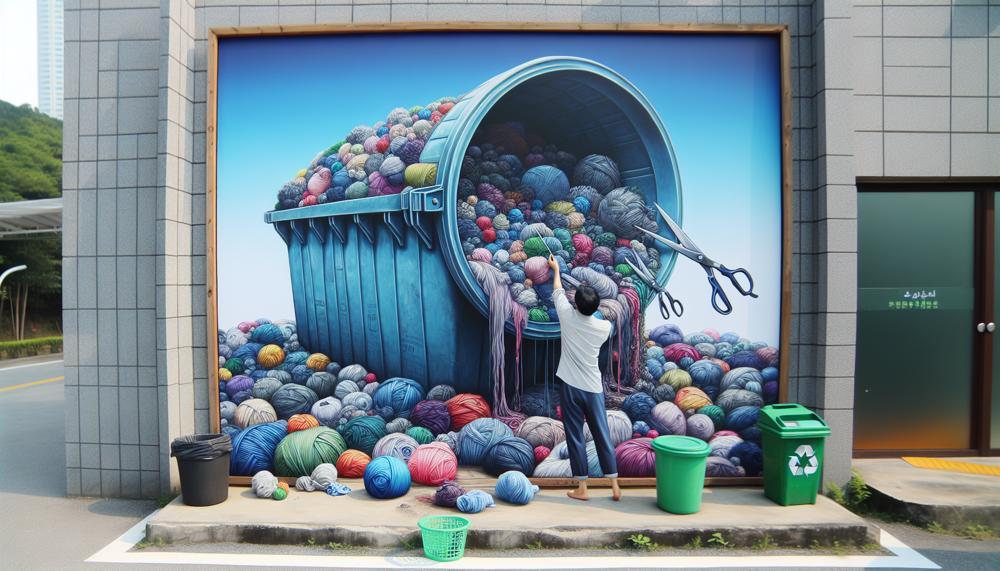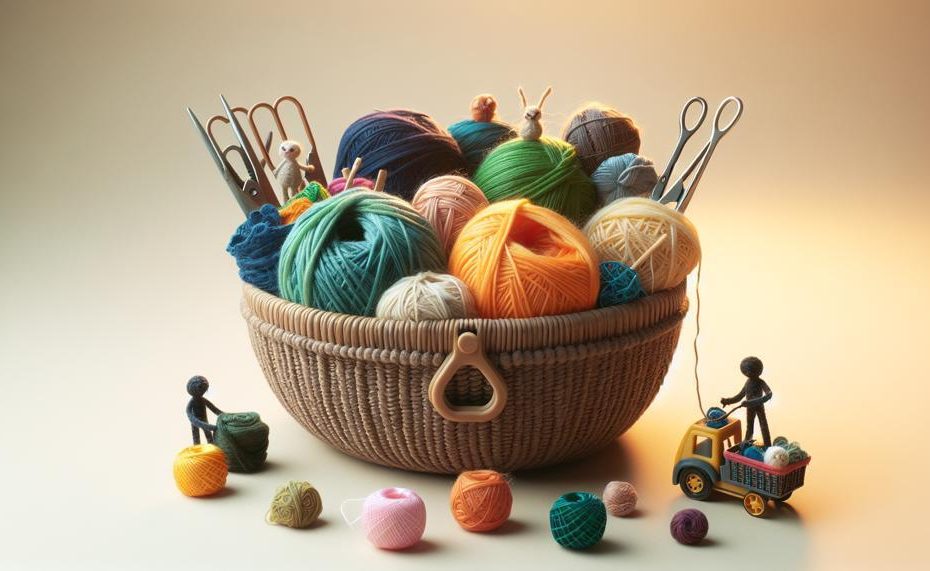Do you love to knit and want to make a positive impact on the environment? Or are you simply intrigued by the concept of recycling yarn?
Recycling yarn not only benefits the planet, but it also opens up new possibilities for your crafting endeavors while saving you money.
In this blog post, we’ll delve into the world of yarn recycling, covering its advantages, techniques, and creative ways to use recycled yarn in your projects.
So, can you recycle yarn?
Yes, yarn can be recycled. You can upcycle leftover yarn into new crafts and decorations. You can also use recycled yarn as-is by washing it with shampoo, soaking it, and hanging it to dry. Then, you can wind it into balls to use. You can also donate unwanted wool to local charity shops, textile recycling shops, or community groups. You can also compost small pieces of yarn, such as leftover linen, cotton thread, and pieces of wool yarn. However, you can only compost natural fibers like cotton, silk, hemp, linen, and wool.
So grab your knitting needles and let’s embark on a journey through the fascinating world of recycling yarn.
Contents
Can You Recycle Yarn?
Recycling yarn has a plethora of benefits, both for the environment and for personal use. It not only helps to reduce waste and minimize the use of harmful materials like plastic but also provides a sustainable source of high-quality yarn at a low cost. Here are some effective methods for recycling yarn:
- Unraveling old garments: A common way to recycle yarn is by unraveling old garments such as sweaters, t-shirts, and denim jeans. This not only provides a source of yarn for new projects but also helps to decrease the amount of textile waste in landfills.
- Repurposing materials: Another excellent way to recycle yarn is by repurposing materials like sheets, pillowcases, and plastic bags. These can be turned into “plarn” (plastic yarn) or cut into strips and used as t-shirt yarn, providing a sustainable alternative to traditional yarn.
- Donating to charity/thrift stores: Donating good clothes to charity/thrift stores not only keeps re-wearable items out of landfills but also offers a sustainable source of high-quality yarn at a low cost.
- Reusing unfinished projects: Instead of throwing away unfinished projects, one can unravel them and reuse the yarn for new creations. This not only saves money but also reduces waste.
- Buying recycled yarns: For those with limited time, there are many options for purchasing new recycled yarns from well-known brands or hand-spun artisanal producers. This supports the growing market for recycled products and can also be beneficial commercially for those who sell their finished crochet items.
- Using natural and organic yarns: While not always practical or accessible, using natural and organic yarns is ideal for the environment. These fibers offer a more eco-friendly alternative to traditional yarns.
- Choosing from different types of recycled yarns: Recycled yarns are available in various forms such as t-shirt yarn, ribbon yarn, barbante, rope, cord, spun plied recycled yarns, and polyester blends. Each type has its own unique characteristics and can be used for different projects.
- Supporting artisanal producers: Recycled yarns can also be made from natural fibers like silk, sari, and banana, spun by artisans in rural communities in India and Nepal. Supporting these producers not only provides a unique crocheting experience but also supports sustainable livelihoods.
Is Yarn Environmentally Friendly?
Recycling yarn has numerous benefits that contribute to a more environmentally friendly fashion industry. These include reducing textile waste, conserving natural resources, decreasing energy consumption and carbon emissions, promoting a circular economy, and creating job opportunities in the recycling and upcycling industry.

These positive impacts demonstrate the importance of recycling yarn for both the environment and the fashion industry as a whole.
| Benefit | Description |
| Reduces textile waste | By collecting discarded or unused yarn, the amount of textile waste that makes its way into landfills is significantly reduced. This not only helps prevent harmful chemicals from being released into the environment but also contributes to a more sustainable and ethical supply chain. |
| Conserves natural resources | The use of recycled yarn decreases the demand for new resources such as water and land, leading to a more sustainable use of natural resources in textile production. This helps reduce the negative impact on the environment and supports a more circular economy. |
| Decreases energy consumption and carbon emissions | The production of new yarn requires a significant amount of energy, which contributes to carbon emissions. By choosing to recycle yarn, this energy consumption is reduced, leading to a decrease in carbon emissions and promoting a more environmentally friendly fashion industry. |
| Promotes a circular economy | By reusing materials, brands can create a self-sufficient system within the fashion industry, reducing the need for new resources and promoting a more sustainable and ethical supply chain. This helps create a more circular economy that benefits both the environment and society. |
| Creates job opportunities | The recycling and upcycling industry creates job opportunities, contributing to a more sustainable and ethical fashion industry by supporting local communities. This not only helps reduce unemployment but also promotes a more socially responsible fashion industry. |
Recycling yarn is a simple yet crucial step towards achieving a more environmentally friendly fashion industry.
By consciously choosing to support brands that use recycled yarn, consumers can make a positive impact on the environment and promote a more sustainable and ethical fashion industry.
Not only does this help reduce waste and conserve resources, but it also supports local communities and creates job opportunities.
Are Yarn And Wool The Same?
Knowing the distinction between yarn and wool is key to effectively recycling these materials. As previously mentioned, yarn can be made from various fibers, both natural and synthetic. However, not all yarns can be recycled in the same manner.
For instance, natural yarns like cotton and wool can be easily recycled through techniques such as shredding and respinning. Conversely, synthetic yarns such as polyester and acrylic require more complex recycling methods due to their chemical composition. Thus, understanding the fiber used in a particular type of yarn can assist in sorting and separating materials for recycling.
Additionally, having knowledge about the properties and strengths of different types of wool can also aid in recycling efforts. For example, cashmere is renowned for its softness but lacks strength, making it more suitable for repurposing into non-wearable items like blankets or rugs rather than being respun into new yarn.
In contrast, merino wool is soft, resistant to allergic reactions, and durable, making it suitable for both repurposing and respinning.
What Are The Differences Between Wool And Yarn?
Recycling wool and yarn made from other materials follows different processes based on their unique compositions. Wool, a natural fiber sourced from animal hair, stands apart from other types of yarn that can be made from synthetic or plant-based materials.
One of the main distinctions between wool and other types of yarn is their composition. Wool is primarily composed of protein fibers, specifically keratin, which gives it its distinct properties such as insulation and water resistance. Conversely, yarn made from materials like cotton, acrylic, or polyester consists of long chains of polymers.
The recycling process for wool and other types of yarn also varies due to their different compositions. For instance, wool can be chemically recycled by breaking down the fibers into their chemical components and reforming them into new products. However, this method requires a significant amount of energy and resources, making it less sustainable compared to mechanical recycling.
In contrast, yarn made from other materials can be mechanically recycled by shredding the fibers and forming them into new products without the use of chemicals. This approach is more environmentally-friendly and energy-efficient.
Is Yarn Compostable?
Yes, yarn made from natural fibers is biodegradable and can be composted instead of being recycled. This means that it can be broken down by micro-organisms into natural materials like water, carbon dioxide, and minerals.
Composting is a natural process that allows for the decomposition of organic materials into nutrient-rich soil.
This makes yarn compostable, as it can be broken down and returned to the earth as a beneficial resource.
| Biodegradable Yarn | Biodegradable yarn is composed of natural fibers such as wool, cotton, or bamboo. | These materials can biodegrade, or be decomposed by living organisms like bacteria. |
| Composting | Composting is a natural process that breaks down organic materials into nutrient-rich soil. | Yarn made from natural fibers can be composted and returned to the earth. |
| Recycling | The recycling processes for yarn vary depending on the composition of the material. | While wool can be chemically recycled, other materials can be mechanically recycled or repurposed. |
On the other hand, yarn made from synthetic materials, such as polyester or nylon, are not biodegradable and cannot be composted. These materials take hundreds of years to break down and contribute to environmental pollution. Therefore, it is important to properly dispose of these types of yarn through recycling or repurposing.
Is Yarn Biodegradable?
The simple answer is yes. However, the process of recycling yarn made from natural fibers is different compared to synthetic yarn.
Let’s take a closer look at the biodegradability and recycling processes for both types of yarn.
Biodegradability of Yarn:
| Type of Yarn | Biodegradability | Decomposition Time |
| Natural Fibers (such as wool, cotton, and bamboo) | Yes | 6 months – 5 years |
| Synthetic Fibers (including polyester, acrylic, and nylon) | No | 100-1000 years |
As seen in the table above, yarn made from natural fibers is biodegradable and will break down over time when exposed to micro-organisms in the environment. This process can take anywhere from 6 months to 5 years, depending on the type of natural fiber used.
On the other hand, synthetic yarn is not biodegradable and will not decompose naturally in the environment. In fact, it can take 100-1000 years for synthetic yarn to break down, posing a threat to the environment during this long period.
Recycling Yarn:
| Type of Yarn | Recycling Process | Possible Uses for Recycled Yarn |
| Natural Fibers (such as wool, cotton, and bamboo) | Can be composted or repurposed into new yarn or textiles | Making new clothing or home decor items |
| Synthetic Fibers (including polyester, acrylic, and nylon) | Can be melted and spun into new yarn or turned into plastic products | Making new clothing, furniture, or plastic items |
Yarn made from natural fibers can be recycled by composting it or repurposing it into new yarn or textiles. This process helps to reduce waste and also provides a sustainable source of material for textile production.
On the other hand, synthetic yarn can be recycled by melting it down and spinning it into new yarn or turning it into plastic products.
5 Creative Ways to Reuse Old Yarn
Here are 5 brilliant ideas to get your creative juices flowing:
Transform old yarn into stunning home decor
- Personalize your walls by wrapping wooden letters with bright and colorful yarn.
- Add texture and color to your home decor by making tassels using different hues of yarn.
- Create practical yet stylish coasters by crocheting with leftover scraps of yarn.
- Make beautiful wall hangings, rugs, cushion covers, or wall art using an assortment of yarns and textures.
Craft one-of-a-kind accessories using yarn
- Braid or knit thin yarn to create unique bracelets, necklaces, or earrings.
- Use thicker yarn to make statement pieces like chunky scarves or trendy hats.
Utilize yarn wrapping techniques for a range of crafts
- Add pops of color and texture to picture frames, vases, letters, and lampshades by wrapping them with yarn.
- Experiment with painting on canvas using yarn for bold and exceptional patterns.
- Try your hand at weaving on a loom or macrame techniques to make eye-catching wall hangings, plant hangers, or even a hammock.
Donate your unused yarn to charitable organizations
- Warm Up America. is an organization that accepts donations of yarn to create blankets for those in need.
- You can also donate your yarn to other charities or local knitting/crocheting groups for various projects.
Create heartfelt handmade gifts using old yarn
- Make cozy scarves or hats for your loved ones using soft and colorful yarn.
- Show your thoughtfulness by gifting a homemade blanket for housewarmings or weddings.
- Add a personal touch to your gifts by creating unique coasters or table runners using different colored yarns.
Also Read: Can You Recycle Hanging File Folders?
Conclusion
In conclusion, recycling yarn is not only a responsible choice for the environment but also a creative and budget-friendly option for your crafting projects.
By reducing waste and preserving resources, it offers an eco-friendly alternative to buying new yarn. And with its unique colors and textures, recycled yarn adds a special touch to your creations.
From unraveling old garments to supporting artisanal producers, there are various ways to recycle yarn. But don’t stop there – explore the endless possibilities of using recycled yarn in your projects, from embellishing home decor to making one-of-a-kind accessories and gifts.
So next time you’re searching for sustainable and cost-effective options for your knitting endeavors, keep in mind that recycling yarn can make a positive impact on the environment while adding character to your crafts.




